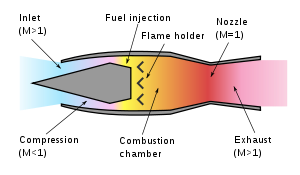| Ramjet | |
|---|---|
A ramjet, sometimes referred to as a stovepipe jet, or an athodyd, is a form of jet engine using the engine's forward motion to compress incoming air, without a rotary compressor. Ramjets cannot produce thrust at zero airspeed and thus cannot move an aircraft from a standstill.
Ramjets require considerable forward speed to operate well, and as a class work most efficiently at speeds around mach 3. This type of jet can operate up to speeds of Mach 6.
Ramjets can be particularly useful in applications requiring a small and simple engine for high speed use, such as missiles, while weapon designers are looking to use ramjet technology in artillery shells to give added range: it is anticipated that a 120-mm mortar shell, if assisted by a ramjet, could attain a range of 22 mi (35 km). They have also been used successfully, though not efficiently, as tip jets on helicopterrotors.
Ramjets are frequently confused with pulsejets, which use an intermittent combustion, but ramjets employ a continuous combustion process, and are a quite distinct type of jet engine.
Design
A ramjet is designed around its inlet. An object moving at high speed through air generates a high pressure region in front and a low pressure region to the rear. A ramjet uses this high pressure in front of the engine to force air through the tube, where it is heated by combusting some of it with fuel. It is then passed through a nozzle to accelerate it to supersonic speeds. This acceleration gives the ramjet forward thrust.
A ramjet is sometimes referred to as a 'flying stovepipe', a very simple device comprising an air intake, a combustor, and a nozzle. Normally the only moving parts are those within the turbopump, which pumps the fuel to the combustor in a liquid-fuel ramjet. Solid-fuel ramjets are even simpler.
By way of contrast, a turbojet uses a gas turbine driven fan to compress the air further. This gives greater efficiency and far more power at low speeds, where the ram effect is weak, but is also more complex, heavier and more expensive, and the temperature limits of the turbine section limits the top speed and thrust at high speed.
Inlet
Ramjets try to exploit the very high dynamic pressure within the air approaching the intake lip. An efficient intake will recover much of the freestream stagnation pressure, which is used to support the combustion and expansion process in the nozzle.
Most ramjets operate at supersonic flight speeds and use one or more conical (or oblique) shock waves, terminated by a strong normal shock, to slow down the airflow to a subsonic velocity at the exit of the intake. Further diffusion is then required to get the air velocity down to a suitable level for the combustor.
Subsonic ramjets don't need such a sophisticated inlet since the airflow is already subsonic and a simple hole is usually used. This would also work at slightly supersonic speeds, but as the air will choke at the inlet, this is inefficient.
The Inlet is divergent, to provide a constant inlet speed of Mach 0.5
Combustor
As with other jet engines the combustor's job is to create hot air. It does this by burning a fuel with the air at essentially constant pressure. The airflow through the jet engine is usually quite high, so sheltered combustion zones are produced by using flame holders that stop the flames from blowing out.
Since there is no downstream turbine, a ramjet combustor can safely operate at stoichiometric fuel:air ratios, which implies a combustor exit stagnation temperature of the order of 2400 K for kerosene. Normally the combustor must be capable of operating over a wide range of throttle settings, for a range of flight speeds/altitudes. Usually a sheltered pilot region enables combustion to continue when the vehicle intake undergoes high yaw/pitch, during turns. Other flame stabilization techniques make use of flame holders, which vary in design from combustor cans to simple flat plates, to shelter the flame and improve fuel mixing. Overfuelling the combustor can cause the normal shock within a supersonic intake system to be pushed forward beyond the intake lip, resulting in a substantial drop in engine airflow and net thrust.
Nozzles
The propelling nozzle is a critical part of a ramjet design, since it accelerates exhaust flow to produce thrust.
For a ramjet operating at a subsonic flight Mach number, exhaust flow is accelerated through a converging nozzle. For a supersonic flight Mach number, acceleration is typically achieved via a convergent-divergent nozzle.
Performance and control
Ramjets have been run from as low as 45 m/s (100 mph) upwards. Below about Mach 0.5 they give little thrust and are highly inefficient due to their low pressure ratios.
Above this speed, given sufficient initial flight velocity, a ramjet will be self-sustaining. Indeed, unless the vehicle drag is extremely high, the engine/airframe combination will tend to accelerate to higher and higher flight speeds, substantially increasing the air intake temperature. As this could have a detrimental effect on the integrity of the engine and/or airframe, the fuel control system must reduce engine fuel flow to stabilize the flight mach number and, thereby, air intake temperature to reasonable levels.
Due to the stoichiometric combustion temperature, efficiency is usually good at high speeds (Mach 2-3), whereas at low speeds the relatively poor compression ratio means that ramjets are outperformed by turbojets or even rockets.



No comments:
Post a Comment